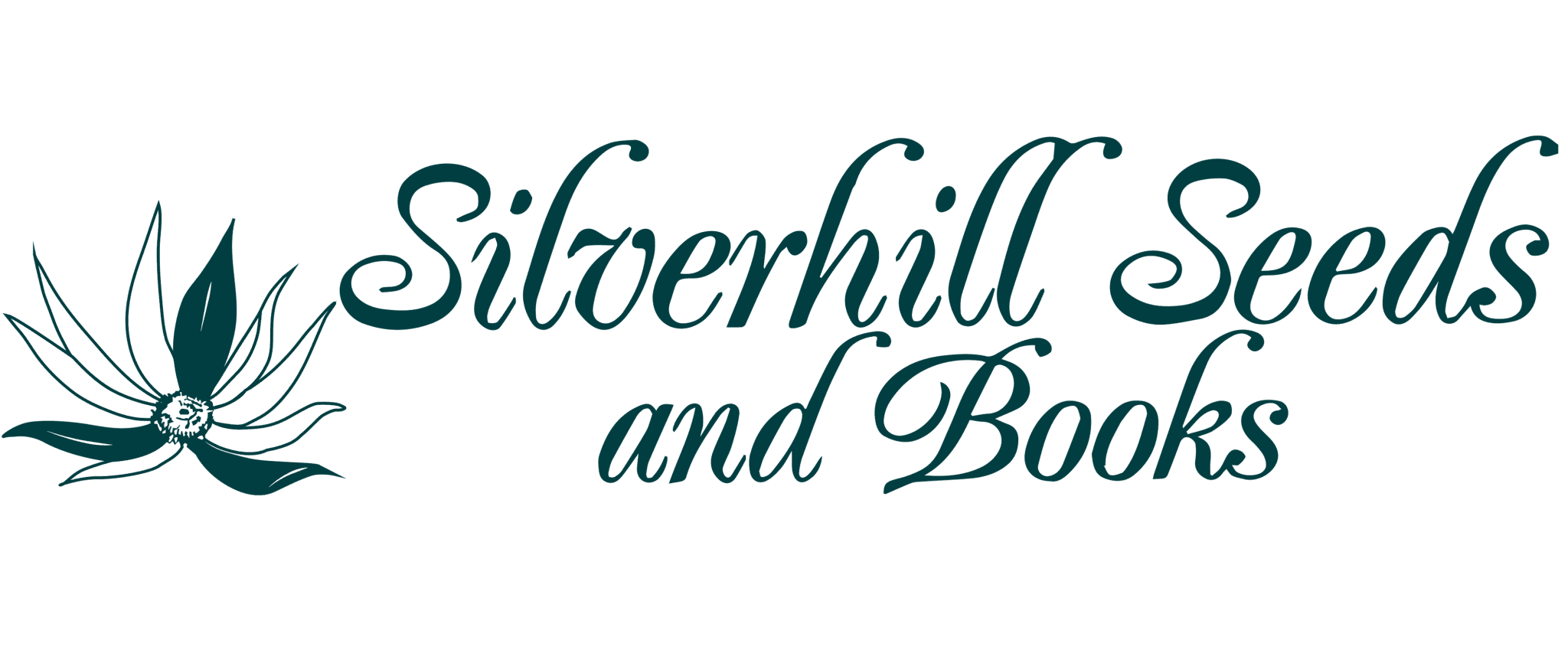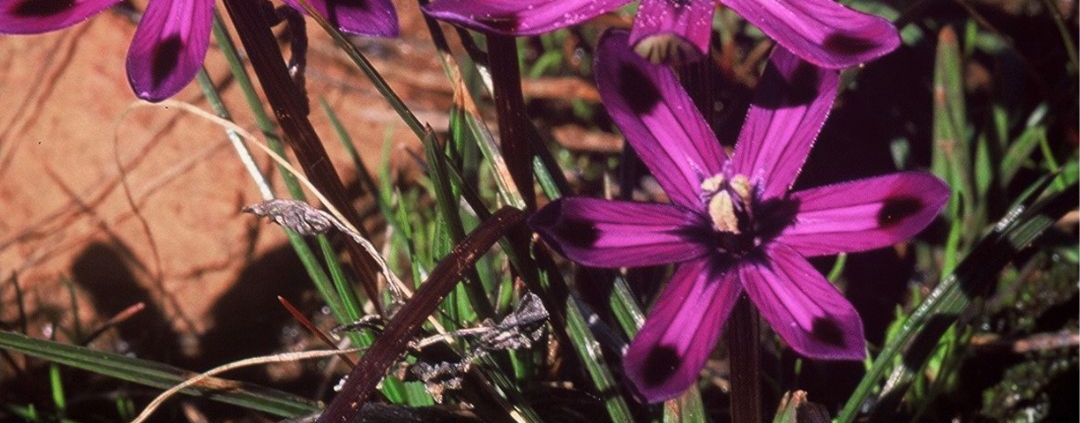From the Archives: Newsletter January 2003
January 2003
Dear Plantsperson,
Welcome to our 2003 catalogue of seeds and books.
Every year our collecting schedules change, dictated by drought, fire and where we happen to be at a particular time. In this catalogue there are a number of new entries and some omissions. For the first time we are offering seeds of Romulea hantamensis (photo on inside front cover), a species with a reputation of being difficult to germinate (a period of cold stratification of the seeds (4 weeks at 4°C) should stimulate germination). We look forward to hearing of your results. This year we concentrated on Namaqualand and the Roggeveld, and visited the areas 5 or 6 times for photography and seed. This means, inevitably, that other areas were neglected, so some species have disappeared off the list. Our peak seed collecting time is from August to December, and it is always difficult to decide where to go as no matter how hard we try, we simply cannot be everywhere at the same time! In our last newsletter (July 2002) we wondered whether the SW Cape would get good winter rain, and yes we did. Many of the cold fronts which bear the rain reached Namaqualand and moved eastwards along the coast, resulting in bumper wheat crops in the winter rainfall areas. The summer rainfall areas had a dry summer last year, and so far this year is even worse. The summer rains normally start in October and continue until March or April. So far most areas have had no rain at all, and extremely high temperatures. Australia is in the same situation and is experiencing the worst drought for decades.
The asbestos saga still drags on! We can no longer afford to spend any more money on a lost cause – every way we turned we landed up in dead ends, literally! All our key witnesses who may have been able to shed light on the origin of the waste are either dead or dying, have Alzheimer’s disease or were too young when it happened! We have now decided to cover the contaminated area with soil, paving and weed matting, and we will prevent any further development of the site.
Earlier in the year at the height of the asbestos saga, we decided to have a break, and we went away to the “Wild Coast” for a week, to forget about the problems at home! South Africa has some magnificent lonely beaches, and the Wild Coast (in the east of the country) has some of the best (at least until the developers find them!). However, on returning home it was “back to reality” and we found that we could hardly get into our house because of book and seed deliveries that had piled up in our entrance hall. The pattern was repeated throughout the entire house, and we suddenly realised that apart from the kitchen, bathroom and our bedroom, our whole house had been taken over by the business. We decided there and then that the business had to move! Fate intervened and the very next day we found a property about 5 minutes walk away from our house so Silverhill now has its own premises, and we have our house back!
This spring we guided a group of American plants people to the flower displays of the Northern and Western Cape. Floral displays in the more arid areas of the country are really fickle and often shortlived, but intensely beautiful while they last. Over the years we have become a little jaded I think, and seeing the display through the eyes of visitors who have no idea what to expect is refreshing and strengthens ones appreciation of the beauty. This year the Western Karoo, and particularly the Hantamsberg, Calvinia and the Roggeveld Plateau produced some of the best floral displays we have ever seen. We went again 10 days later on our own, and it was as though it had never happened. Such is the brevity of displays in these arid areas.
In June/July we went on our customary trip to the north of Southern Africa, including Zimbabwe and Botswana. We obtained a little seed, though many of the trees had not even flowered in the last season because of the drought in the area. The whole political situation in Zimbabwe is such a disaster and the people so desperate, that it is unlikely we will be back until there has been a change of government. Every evening when we had our shower (standing under a tree under a bucket full of water), we had problems with swarms of wild bees, desperately looking for water. We found that the only way to cope with them was to give them their own dedicated paper plate full of water, and then they left us alone!
The dry conditions seem to have brought out a large number of impressive snakes. Normally years go by and if we see one or two snakes, that is a lot. This year we have seen about 9 so far – some very large cobras, usually moving quickly across the road, and many puffadders lying in the sun on the road, and requiring a prod with a long stick to make them move! We normally see these snakes immediately after we have been wandering through the thick bush in our sandals, and it makes us shudder!
Travel in Africa has other dangers apart from bees and snakes. While picking up Acacia pods under a tree in the bushveld miles from anywhere, Rachel felt a thorn prick her. She looked at it, and to her horror saw a hypodermic syringe needle stuck deeply into her thumb. One’s first reaction is blind panic since Aids/HIV in Africa is epidemic and we were all for rushing off to the nearest clinic and starting anti-HIV treatment. However, sanity prevailed, and apart from making the wound bleed profusely and washing her hand, we did nothing. The number of documented cases of HIV being transmitted by needle pricks is extremely low, and two HIV tests (3 weeks and 3 months later) were both negative. Phew!
Modern taxonomy is playing havoc with our plant names, and over the last few years we have seen, amongst many others, Homerias and Galaxias disappear and reappear as Moraeas, Sarcocaulons are now Monsonias, and the whole family Mesembryanthemaceae has gone into Aizoaceae! There is, no doubt, good scientific justification for these changes, but it is a pity since many of the genera that have disappeared were cohesive and instantly recognisable groups of plants. Some of the changes are reflected in our catalogue (for example Sutherlandia is now Lessertia, Homerias are sold as Moraeas), but some we have not changed as we stubbornly refuse to accept the new taxonomy! So Galaxias are still Galaxias, and Sarcocaulons are still Sarcocaulons. I suppose we will have to change eventually, but for the moment we will remain out of date.
When wandering around looking for seed, we often come across horticulturally worth while plants. On the inside of the back cover is a picture of some of our Ornithogalum hybrids which we have selected and bred, and are now being produced by Frontier lab. They have immense potential as pot plants as well as cut flowers. At present we have a colour range from dark orange through peach shades to yellow, cream and white. There must have been about 3 or 4 000 of them in flower this spring in our glasshouse – they were spectacular and we spent a fair bit of time oohing and aahing over them! The tissue culture lab is busy and doing well, as is the book business. Not only do we travel around seed hunting now, but we visit as many second hand book shops as possible looking for out of print botanical books.
In our new premises we have been be-friended by a cat. His past owner (our neighbour) moved on and left him behind, so he has more or less moved into Silverhill. All our staff look after him and give him more fuss that he can cope with!
Our human staff compliment remains the same as last year, all one year older, and they all seem to be happy with the move. Maybe having a swimming pool in the garden helps! Rachel’s mother still works for us every day, and is now muttering about the lack of a salary for all her labour!
When ordering, please remember to put your name and address on the order. This year we had three nameless orders which are still sitting here waiting to be claimed. Please also remember to put your full name and address on your e mails – “John” or “Jane” does not help us much! Two more requests – please order in alphabetical order as it makes completing the order much quicker and simpler, and please try to organise your order so that the Bulbs are all together, the Succulents together, etc, instead of mixing them all into one list. It really makes a huge difference to the people finding the seeds, and the people writing the invoice. Thanks.
The system with phytosanitary certificates for the USA orders seems to be working well, but we have had to increase our charges to US$3 per order. The post office official in Chicago where Rachel’s brother posts the parcels was very suspicious of all the little boxes at first, but is now perfectly happy with them.
Finally, while this catalogue is at the printer we are off to see the total solar eclipse in the far northern part of South Africa. Personally, we both think that we are a bit daft – to drive 2000km to see a 90 second period of darkness, then drive 2000km home again is not really sane! However it is the last chance in Rod’s lifetime that he will get to see a total eclipse (the next one is in 30 years time!), so off we go! We will tell you about it in the next news letter – meanwhile, happy gardening!
Best wishes
Rod & Rachel Saunders



